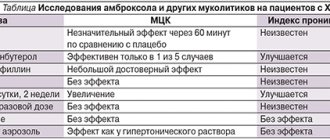The effectiveness of bromhexine has been confirmed by medical practice for a very long time - long before evidence-based medicine was recognized as the “gold standard” of quality, therefore this drug is classified as over-the-counter.
The modern pharmacological market offers customers several commercial names for this drug:
- Ambroxol.
- Lazolvan.
- Ambrobene.
- Bromhexine Berlin-Chemie.
In all of the above drugs, the active ingredient is bromhexine hydrochloride. Only the country of origin and cost differ. Even their effectiveness is relatively identical (a rare exception when a domestically produced drug is not inferior in quality to imported ones).
Today Bromhexine is available in several dosage forms:
- Tablets (available for children and adults, dosage differs).
- Syrup (exactly the same, children's and adult versions are offered).
- Solution for inhalation (only imported Lazolvan and Ambrobene are presented in this form).
You should choose a dosage form based on the age and condition of the patient - they do not differ in effectiveness.
Mechanism of action. Nuances of implementing the effect.
Pharmacodynamics and pharmacokinetics
Bromhexine 8 Berlin-Chemie is characterized by secretolytic (mucolytic) and secretomotor (expectorant) effectiveness, and also has a weak antitussive effect. Taking the drug reduces the viscosity of bronchial secretions , stimulates ciliated epithelial , increases the amount of sputum and promotes its rapid discharge. In addition, the drug activates the production of endogenous surfactant the alveolar epithelium during respiration . The maximum effectiveness of therapy is observed on days 2-5 from the start of taking the drug.
When taken orally (inside) for 30 minutes, almost complete absorption of bromhexine (99%) in the gastrointestinal tract is observed. The bioavailability of the drug is at the level of 80%. Bromhexine is 99% bound to plasma proteins It has the ability to penetrate the blood-brain and placental barriers, as well as into the milk of a nursing mother. Hepatic metabolic transformations occur through oxidation and demethylation , up to the formation of ambroxol . The average T1/2 due to slow reverse tissue diffusion is 15 hours. Excretion is carried out by the kidneys (urine) in the form of metabolites . Repeated use leads to the accumulation of the drug in the human body. With chronic renal failure of metabolic products is impaired.
pharmachologic effect
The drug has a number of therapeutic properties, providing mucolytic, expectorant and antitussive effects.
Effective against dry cough in adults and children. Due to its special composition, its ability to liquefy and remove mucus from the bronchopulmonary system is noted. The drug stimulates the production of a special substance that settles on the surface of the respiratory organs and helps protect them.
Bromhexine is quickly adsorbed in the body. After oral administration, the pharmacological properties develop after 30-60 minutes. The drug products are eliminated through the liver and excretory organs in an average of 12-15 hours.
Indications for use
The use of Bromhexine Berlin-Chemie is indicated in the case of bronchopulmonary diseases of a chronic or acute course, accompanied by the production of viscous sputum:
- pneumoconiosis;
- bronchial asthma;
- cystic fibrosis;
- pneumonia;
- emphysema ;
- tracheobronchitis;
- bronchiectasis;
- obstructive bronchitis;
- tuberculosis.
Contraindications
Taking bromhexine is absolutely contraindicated if:
- breastfeeding;
- personal hypersensitivity to bromhexine and/or other components of the drug;
- sugar intolerance;
- pregnancy in the first trimester;
- exacerbation of peptic ulcer ;
- under the age of 6 years.
Relative contraindications are:
- / liver pathologies ;
- tendency to gastrointestinal bleeding ;
- disturbances of bronchial motility with excessive concentration of secretions.
Side effects
As a rule, treatment with bromhexine is tolerated without any negative effects.
In some rare cases, the following were observed: nausea / vomiting , dyspeptic , dizziness , exacerbations of peptic ulcers , shortness , headaches , chills, fever, as well as allergic manifestations (skin rash , swelling , rhinitis ).
anaphylactic shock may occur .
Sometimes an increase in the activity of liver transaminases .
If any allergic , you must stop taking bromhexine and inform your doctor about the observed symptoms.
Side effects
Taking an antitussive drug may cause side effects. They develop when the course or therapeutic dose is not followed. The most commonly observed conditions are:
- Nausea followed by vomiting.
- Headache.
- Dizziness.
- Increased activity of liver enzymes.
- Exacerbation of ulcerative pathologies of the gastrointestinal tract.
- Allergic reactions - hyperemia, swelling, itching, skin rashes.
- Pain in the epigastric region, stool disturbance.
Instructions for use Bromhexine 8 Berlin-Chemie
The instructions for Bromhexine Berlin-Chemie include oral (oral) administration of tablets (dragées). The tablets should be taken whole immediately after meals and washed down with 200-250 ml of water.
A single dosage of B romhexine for patients over 14 years of age is 1-2 tablets (dragées) taken three times per 24 hours.
For body weights up to 50 kilograms, as well as at the age of 6-14 years, a single dose is equal to 1 tablet (dragée) 8 mg, with a similar frequency of doses per day.
In case of existing / liver pathologies, it may be necessary to reduce the recommended dosage or reduce the number of doses, which requires consultation with a doctor.
The duration of prescribed therapy is determined by the attending physician and depends on the diagnosed disease and the severity of its course. If treatment is necessary for more than 4-5 days, you should consult a doctor.
For the treatment of children from 2 to 6 years old, the Berlin-Chemie company produces bromhexine syrup with a dosage of 4 mg/5 ml, which is taken three times a day, 5 ml.
How to take Bromhexine for adults
The product must be used as directed by a specialist. The dosage and duration of the course depend on the diagnosis, general health and age of the patient.
Adult patients are prescribed the drug in different forms. Tablets should be taken regardless of food, 1-2 tablets up to 4 times a day, with a sufficient volume of water.
The medicine in the form of syrup is drunk according to a similar scheme as tablets. The recommended dosage is 8-16 mg 3-4 times a day.
The duration of treatment with Bromhexine is at least 4 days, maximum 4 weeks. It is important to maintain water balance while using the drug.
Overdose
No life-threatening adverse effects were observed when taking excessive doses of bromhexine Possible symptoms of overdose were limited to nausea / vomiting , diarrhea and other dyspeptic symptoms.
The recommended treatment is to induce vomiting and cleanse the gastrointestinal tract (if an overdose is detected in the first 60-120 minutes). Subsequent therapy should be appropriate to the observed symptoms.
Interaction
The drug is not compatible with alkaline solutions .
Due to the difficulty of removing liquefied sputum , the combined use of the drug with drugs that have a depressing effect on the cough center (including codeine-containing drugs ) should be avoided.
In the first 4-5 days of antibiotic therapy using Amoxicillin , Erythromycin , Oxytetracycline , Cephalexin and Ampicillin and simultaneous administration of Bromhexine bronchial secretions may increase .
In what cases is it recommended to take Bromhexine?
The drug taken orally has a pronounced secretolytic and secretomotor effect on the mucous membrane of the bronchial tract. Accordingly, as a result of the implementation of this effect, the intensity of bronchial secretion increases significantly, the viscosity of mucus (sputum) decreases and the activity of the cilia of the ciliated epithelium increases. All these factors together contribute to the acceleration of the movement of mucus (phlegm) through the respiratory tract.
Please note that Bromhexine is effective only for dry cough. Accordingly, it makes sense to use it (like all other mucolytics) in the initial stage of the disease. If the patient is already expelling large quantities of sputum, then there is no point in enhancing the mucociliary effect - with a high probability this can lead to the syndrome of “flooding” the bronchial tree with sputum, and will worsen the patient’s condition.
Pathologies (diseases) for which it is recommended to take bromhexine include infections of the upper, lower and middle parts of the respiratory tract (bronchitis, laryngitis, pneumonia). Please note that even with the mildest viral infection, Bromhexine is used only in complex therapy, because it does not directly affect the microorganism that caused the disease. This drug only alleviates the patient’s condition by helping to remove phlegm.
special instructions
During therapy, you need to consume an increased amount of fluid, which helps to increase the secretolytic effectiveness of Bromhexine .
If bronchial motility or if there is a large volume of sputum , caution should be exercised, as these conditions contribute to the retention of secretions .
In case of severe kidney pathologies, Bromhexine .
In order to facilitate the removal of bronchial secretions , it is recommended in childhood to combine Bromhexine with vibration massage of the chest or postural drainage .
How to take Bromhexine for children
The medicine is widely used to treat children. Syrup is given to children from 2 years old, tablets from 6 years old.
The drug is taken according to the following scheme, depending on age:
- 2-6 years - 2.5-5 ml of the drug per day is recommended;
- 6-10 years - 5-10 ml of syrup;
- over 10 years old - 10 ml 3 times a day;
- 6-14 years old are prescribed 8 mg of Bromhexine per day in tablet form.
The pharmacological effect usually occurs after 4 days. For better and easier removal of sputum, you should simultaneously massage and give the child the required amount of liquid.
Analogs
Level 4 ATX code matches:
Mukolik
Abrol
Ambrosan
Bronchorus
ACC 100
ACC 200
ACC Long
ACC
Mukolwan
Lazolvan
Bromhexine 8
Bromhexine
Bronchobos
Carbocisteine
Erdomed
Pulmozyme
Pectolvan C
Halixol
Ambrobene
Acetylcysteine
- Ambrobene;
- ACC;
- Acestine;
- Libexin;
- Ambroxol;
- Bronchoxol;
- Ascoril;
- Lazolvan;
- Sinupret;
- Fluditek;
- Flavamed;
- Fluimucil;
- Halixol , etc.




